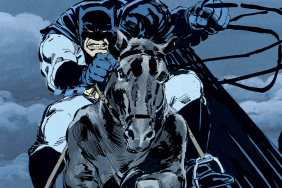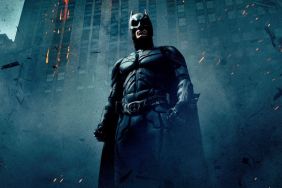
We’re just two weeks away from The Dark Knight Rises – are you excited yet? It’s no surprise that even more material on the tight lipped film is coming out as we get closer to the release date and this time it was in the form of almost 50 pages of production notes from the official webpage.
Some of the highlights from the notes include:
Director Chris Nolan on the time lapse between films: “Our story picks up eight years later, when it seems that Batman and Commissioner Gordon have succeededthe Dark Knight is no longer needed in Gotham. In that regard, Bruce Wayne has won the battle, but he is traumatized by what happened and doesnt know how to move on from being the figure of Batman. The Dark Knight Rises very much deals with the consequences of his and other characters actions in the previous films.”
Christian Bale on Bruce Wayne’s journey throughout the series:“In Batman Begins, you see the tragedy and the pain that motivates this angry young man, who feels useless and is searching for a pathwho wants to find out who he is and what he can become. Then in The Dark Knight, hes discovered that path. He is useful; he is doing what he imagines is the best thing for him to be doing in his life. Now, we are eight years on and he has lost the one thing that gave him a purpose until he is forced to deal with a new threat to the city and to himself.”

On Bane: “While the Scarecrow was a madman and the Joker an anarchist, Bane is a terrorist in both his mentality and his actions, says actor Tom Hardy, who plays Batmans new arch-nemesis. He is physically intimidating and hes also very intelligent, which makes him even more dangerous.
Nolan relates: “In deciding on who the next villain would be, it was imperative that it was someone completely different from the Jokerthat he be a brute force. The physical component of what Bruce Wayne does as Batman is of extraordinary importance, and we had not truly challenged that in the first two films. I really wanted to see Batman meet his match physically, as well as intellectually. Bane is raw strengthwith a fanatical devotion to duty, and that combination makes him unstoppable.”
“This is the first time it appears highly unlikely that Batman will come out on top in a physical altercation, Bale allows. He has been dormant for years, so hes in a weakened condition to begin with, and Bane is not only incredibly strong but ruthless in terms of his sheer militancy and the ideology that drives him.”
Tom Hardy attests: “Bane has come to do a job and has no feelings of remorse.”

On Catwoman, Anne Hathaway admits: “Its hard to reveal anything about Selina Kyle because she is intensely private and very mysterious. She has her own code of ethics, which sometimes involves doing things that other people might consider questionable.”
Screenwriter Jonathan Nolan says: “Something about her morally ambiguous philosophy finally gives Batman someone he can relate to. In a weird way, shes the yin to his yang. The dynamic between them is so freshthe playful way she kind of pokes fun at himit sparks a connection between them and takes some of the somberness away from his character.”
“I think Selina does what is necessary to survive,” relates Hathaway, “and that includes crossing a few lines that others might find unforgivable. Even if she wants to change, its hard to escape your past and she does have a past. That makes her vulnerable, especially these days when anyone with a computer or smartphone can look up almost anything about you. Everybody has moments in life when they think, If I knew then what I know now Selina might like the opportunity not to have to live by the choices she was forced to make up to this point.”

On the IMAX cameras: The director also raised the bar for The Dark Knight Rises in expanding on hisuse of IMAX cameras. Nearly half of the movie was shot with the large-format cameras, utilizing ultra resolution 15 perf/65-millimeter film. Nolan states, We got great results with the IMAX cameras on the last film. I appreciate what it offers from the technical side, but Im most interested in what it can give me as a storytelling tool. How can it help me pull the audience deeper into this world? IMAX provides the broadest possible canvas, creating the most immersive experience.
On Commissioner Gordon: “Gordon was more useful to the political leaders of Gotham when the city was overrun by organized crime, Nolan points out. Now that is under control, so there are people eyeing his job, presuming hes no longer needed. But Gordon has been struggling with the fact that all of this is based ona false foundation.
Its a secret thats eaten away at him for years, confirms Gary Oldman. Crime is at an all-time low in Gotham, but Gordon knows that its tainted. Now hes ready to come clean, but there doesnt seem to be a right time or place, and he also questions if the city is ready for the truth. Then, because of Bane, hes in the field again. I think hes like a soldier who likes to be on the front lines, getting his hands dirty. Hes probably been doing a lot of paper pushing in the intervening years and that has dampened his spirits. Now you really feel like the old Gordon is back.

On Batman and Bane’s epic fights: Nolan affirms, This was very much a toe-to-toe, blow-to-blow physical clash, and Christian and Tom put an incredible amount of work into it. Just the demands of the costumesone character has the lower half of his face obscured, the other the upper halfposed problems. They had trouble hearing each other because they were wearing those masks and working in very noisy environments while performing these feats.”
It required very intense preparation, the director continues. And when it came time to shoot, Christian and Tom worked extremely well together. It was frighteningly real, and quite intimidating to see these iconic, larger-than-life characters really go at it. There are plenty of other large-scale action scenes in the film, but that face-to-face confrontation between these two adversaries was something I really felt was the centerpiece of the film.

On the prologue of the film: Tom Struthers went to great measures to eliminate risks to the aerialists who would be dropping from the C-130 onto the turboprop. The stunt coordinator recounts, To my knowledge, its never been donewhere four people flew out of the back of an aircraft on separate lines and land on another plane. So we did a great deal of testing with dummies and different kinds of rigs before we ever put an actual person up. We had emergency procedures in place to allow them to cut away and parachute to the ground, which thankfully were never necessary. The guys who did it were fantastic.
There were also preparations being done on the ground, where the fuselage of the CIA plane would eventually fall to earth. Everything was cleared from the area, to ensure that there was no threat to people or wildlife. The weather also cooperated, giving the filmmakers clear skies.

The struggle unfolding inside the turboprop plane was filmed at Cardington, a converted airship hangar north of London. Corboulds team constructed the fuselage of the plane on a gimbal, which was able to tip the aircraft from horizontal to vertical and rapidly roll it from side to side, severely testing the equilibrium of the cast and crew. I dont know why on Chriss sets we always end up tumbling around or turning upside down, Pfister says, only half-joking. Logistically, it makes for quite a challenge when youre shooting it, but it also makes for a great bit on film.

On the Batcave: Nathan Crowley, who teamed with fellow production designer Kevin Kavanaugh on this film, explains, Chris and I pondered how to mix the Batcave and the Bat-Bunker, which is incredibly geometric and modern and everything is cleanly recessed into the walls. It occurred to us that we could carry over the same idea by flooding the Batcave so everything is hidden underwater. When you enter, its just a cave, but you press a button and up come these perfect cubes that hold different objects, from the Batsuit to a super computer.
Nolan offers: Its a terrific combination of the tactile reality of the Batcave and the functionality of the Bat-Bunker.

On the music of the film: For this final installment, Zimmer included echoes of the earlier scores, but, he says, We went in a completely different direction for Bane. I wanted to use a big symphony orchestra, but I said to them, Im going to make you unlearn everything youve learned. Im going to treat you as if you were a primeval drum circle. And it turned out to be very liberating for them, like a musical adventure, he smiles.
Zimmer says that, like the character, the theme accompanying Selina Kyle is full of ambiguity, which is far more interesting than just being bad or good. Chriss movies always contain a certain amount of ambiguity, and I try to put some of that into the music.
You can read all of the production notes for the film here.
The Dark Knight Rises opens in theaters and IMAX on July 20.









